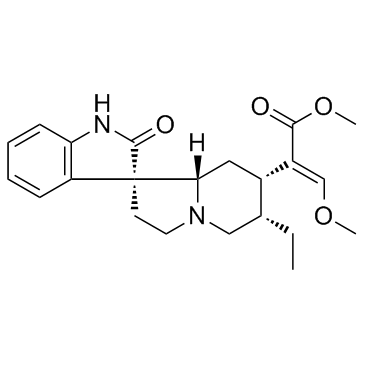
Corynoxine B
CAS No. 17391-18-3
Corynoxine B( —— )
Catalog No. M31769 CAS No. 17391-18-3
Corynoxine B is a Beclin-1-dependent autophagy inducer. It is an natural alkaloid isolated from Uncaria rhynchophylla (Miq.) Jacks (Gouteng in Chinese).
Purity : >98% (HPLC)
 COA
COA
 Datasheet
Datasheet
 HNMR
HNMR
 HPLC
HPLC
 MSDS
MSDS
 Handing Instructions
Handing Instructions
| Size | Price / USD | Stock | Quantity |
| 5MG | 209 | In Stock |


|
| 10MG | 344 | In Stock |


|
| 50MG | Get Quote | In Stock |


|
| 100MG | Get Quote | In Stock |


|
Biological Information
-
Product NameCorynoxine B
-
NoteResearch use only, not for human use.
-
Brief DescriptionCorynoxine B is a Beclin-1-dependent autophagy inducer. It is an natural alkaloid isolated from Uncaria rhynchophylla (Miq.) Jacks (Gouteng in Chinese).
-
DescriptionCorynoxine B is a Beclin-1-dependent autophagy inducer. It is an natural alkaloid isolated from Uncaria rhynchophylla (Miq.) Jacks (Gouteng in Chinese).
-
In Vitro——
-
In Vivo——
-
Synonyms——
-
PathwayOthers
-
TargetOther Targets
-
Recptor——
-
Research Area——
-
Indication——
Chemical Information
-
CAS Number17391-18-3
-
Formula Weight384.47
-
Molecular FormulaC22H28N2O4
-
Purity>98% (HPLC)
-
SolubilityIn Vitro:?DMSO : 83.33 mg/mL (216.74 mM)
-
SMILES——
-
Chemical Name——
Shipping & Storage Information
-
Storage(-20℃)
-
ShippingWith Ice Pack
-
Stability≥ 2 years
Reference
molnova catalog



related products
-
Bractoppin
Bractoppin is a drug-like inhibitor of phosphopeptide recognition by the human BRCA1 tandem (t)BRCT domain (IC50 = 0.074 μM), which selectively inhibits substrate binding with nanomolar potency in vitro.
-
Canthaxanthin
Canthaxanthin is a red-orange carotenoid that belongs to the xanthophyll group.
-
Carbazochrome
Carbazochrome?is an antihemorrhagic, or hemostatic, agent that will cease blood flow by causing the aggregation and adhesion of platelets in the blood to form a platelet plug, ceasing blood flow from an open wound.



 Cart
Cart
 sales@molnova.com
sales@molnova.com


